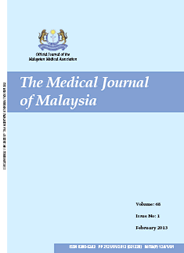MJM, Vol 70 Supplement 1 September 2015
Nutritional status of Pos Raya Orang Asli primary
school children by percentiles of height, weight and BMI compared to WHO standards
Faculty of Medicine, Quest International University Perak, Ipoh, Perak Darul Ridzuan, Malaysia
ABSTRACT
Introduction: Malnutrition is global health problem and prevalence of overweight and obesity become a public a disease burden especially for high and middle-income countries. In Malaysia, overweight and obesity prevalence is high and trend is increasing in nature. It is common for both over 18 years of age and below 18 year of age children and adolescents. But, the rural children especially of ethnic minority groups may have different patterns.
Methods: A cross-sectional study was conducted to determine the nutritional status of primary school children of Pos Raya Orang Asli community. Data collection was done by recording age and measuring anthropometric measurements namely, height (in centimetres), and weight (in kilograms) of each child and entered into the WHO Anthro Plus format of ‘Nutritional Survey’ and nutritional status of individual along with percentile curves (weight-for-age, height-for-age and BMI-for age) were obtained. After data on whole class of children were entered, the curves for weight-for-age, height-for-age and BMI-for-age representing the class along with the WHO standard curve were obtained.
Results: Over 10 years of age (class five and six) weight-for-age curve is not available. In all classes, all nutritional status curves of children were shifted to the left compared to WHO standard curves. Marked under nutrition is observed especially in height-for-age curve showing stunted growth. Regarding BMI-for-age, the curves are as near as WHO standard curves. Weight-for-age curves also show marked under-nutrition.
Conclusion: It will be concluded that nutritional status of Orang Asli children of Pos Raya Primary School showed under-nutrition when compared to WHO standard. For individuals, majority falls under yellow and red zones of under-nutrition in all classes (except class 5 and 6 where no calculation is available for weight-for-age) regarding weight-for-age and height-for-age. For BMI-for-age, majority are in green zone and some under-nutrition and few children with over-nutrition.
